Aboriginal Australians originated from a single wave of migrants who left the African continent about 72000 years ago, says an international team of researchers, including elders and leaders from various Aboriginal Australian communities. In fact, every human being on Earth today originally came from these people who migrated out of Africa.
Some of the elders were co-authors in a new study that has been published in the prestigious journal Nature.
The authors, from the UK, Denmark, Switzerland, Spain, Australia, Portugal, Germany, Saudi Arabia, Malaysia, Norway, New Zealand, Estonia and the United States, claim theirs is the first significant investigation into the genomics of Aboriginal Australians.
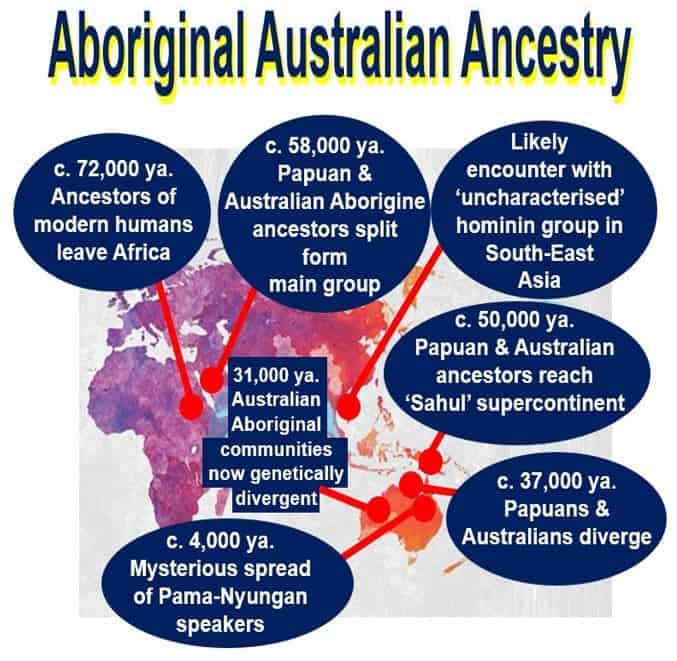 In the comments in this map, the abbreviation ‘ya.’ stands for ‘years ago’. Genetic analyses suggest that Aboriginal Australians and Papuans arrived in their present homelands fifty-thousand years ago and were probably the first humans to cross and oceans. They are possibly the oldest living civilization. The two populations split about 37,000 years ago with the Aboriginal Australians remaining entirely isolated until 4,000 years ago. (Image: adapted from cam.ac.uk)
In the comments in this map, the abbreviation ‘ya.’ stands for ‘years ago’. Genetic analyses suggest that Aboriginal Australians and Papuans arrived in their present homelands fifty-thousand years ago and were probably the first humans to cross and oceans. They are possibly the oldest living civilization. The two populations split about 37,000 years ago with the Aboriginal Australians remaining entirely isolated until 4,000 years ago. (Image: adapted from cam.ac.uk)
Where did Aboriginal Australians come from?
The study uncovered several important findings regarding early human populations. These include compelling evidence of a single ‘Out of Africa’ event, and of a ‘ghost-like’ population – never identified before – that spread. All the findings combined provided a basis for today’s Aboriginal cultural landscape.
This first major genomic study of Aboriginal Australians ever undertaken confirms that all modern non-African populations are descended from this single wave of Africans who migrated approximately 72,000 years ago.
Scientists sequenced the complete genetic information of twenty-five Papuans from New Guinea and 83 Aboriginal Australians, and produced a host of significant new findings about the origins of all humans alive today.
Apart from the prevailing conclusion that the vast majority of the genomes of non-Africans who exist today stem from one ancestral group of migrants who ventured out of their continent together, there are several important findings. These include:
– Irrefutable evidence that Aboriginal Australians are descended directly from the first humans to inhabit Australia – a subject that is continuously being disputed.
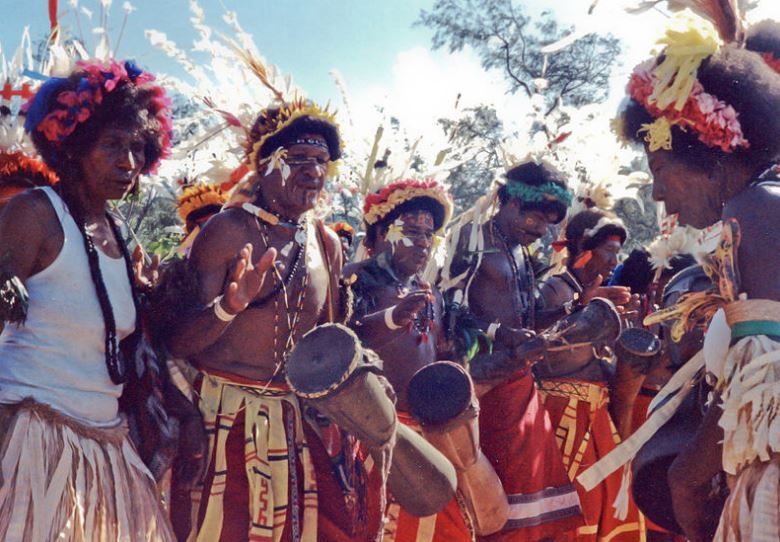 Papuan Drummers and dancers. The faint signature of an earlier migration out of Africa may be found in the people from Papua New Guinea. (Image: Wikipedia)
Papuan Drummers and dancers. The faint signature of an earlier migration out of Africa may be found in the people from Papua New Guinea. (Image: Wikipedia)
– Compelling evidence of an uncharacterised – and possibly unknown – early human species that interbred with anatomically modern humans as they migrated across the Asian continent.
– Evidence that an enigmatic dispersal from the northeastern part of Australia about four thousand years ago contributed to the cultural links between Aboriginal communities today.
Migrants within Australia suddenly vanished
These people who migrated within Australia defined the way humans spoke and thought, but then vanished from most of the continent, in a ‘ghost like’ manner.
The study’s senior authors are from the Wellcome Trust Sanger Institute, The Universities of Cambridge, Bern, Copenhagen, and Griffith University Australia.
Within the University of Cambridge, members of the Leverhulme Centre for Evolutionary Studies also contributed to the study by helping to place the genetic information which the team had gathered in the field within the context of wider evidence regarding early human population behaviours and migrations patterns.
Professor Eske Willerslev, who works at St John’s College, University of Cambridge, the Sanger Institute, and the University of Copenhagen, and initiated and led the research, said:
“The study addresses a number of fundamental questions about human evolution – how many times did we leave Africa, when was Australia populated, and what is the diversity of people in and outside Australia?”
“Technologically and politically, it has not really been possible to answer those questions until now. We found evidence that there was only really one wave of humans who gave rise to all present-day non-Africans, including Australians.”
 Aboriginal Australian communities have had a very troubled history with genetics researchers. A new generation of genetists is attempting to repair relations. (Image: nature.com/news)
Aboriginal Australian communities have had a very troubled history with genetics researchers. A new generation of genetists is attempting to repair relations. (Image: nature.com/news)
Modern human left Africa 72,000 years ago
We know that anatomically-modern humans left Africa about 72,000 years ago, and eventually spread across Europe and Africa. Outside the African continent, Australia has one of the longest histories of continuous human occupation, dating back approximately fifty-thousand years.
Some scientists believe that this deep history suggests that Australians and Papuans stemmed from an earlier migration than the Eurasian peoples’ ancestors. Other suggest that they split from the Eurasian progenitors within the African continent itself, and left in a completely separate wave.
The only genetic evidence we had for Aboriginal Australians, which was needed to investigate these theories, came from one tuft of hair and two unidentified cell lines – that is, until this latest study.
Community elders collaborated in this study
The new findings dramatically improve that picture. Working closely with community elders, the ethical board of Griffith University, and representative organisations, Prof. Willerslev and colleagues got permission to sequence dozens of Aboriginal Australian genomes, using DNA extracted from people’s saliva.
They compared the new DNA data with existing genetic information about other populations. The scientists modelled the likely genetic impact of varying human dispersals from Africa and towards Australia, looking for patterns that best matched the data they had acquired.
Professor Robert Foley and Dr. Marta Mirazon Lah, both from the Leverhulme Centre, helped by analysing the likely correspondences between this newly-acquired genetic information and a wider framework of existing archaeological and anthropological data about early human population movements.
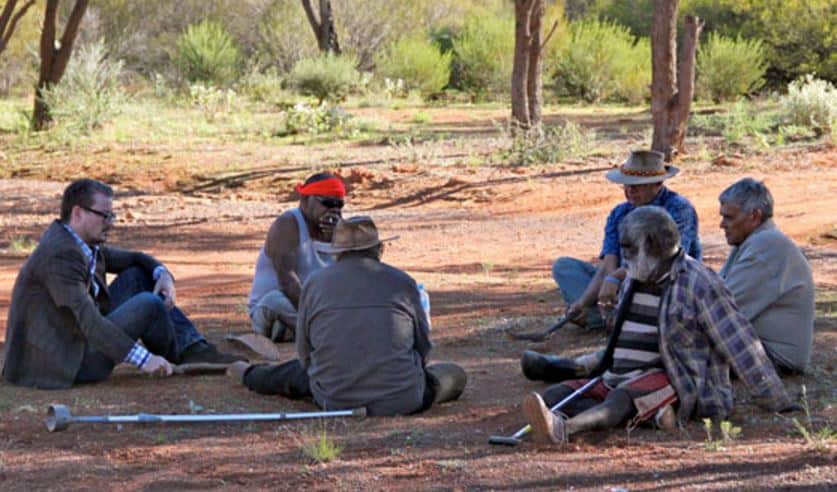 Professor Eske Willerslev talking to Aboriginal elders in the Kalgoorlie area in southwestern Australia in 2012. (Image: sanger.ac.uk)
Professor Eske Willerslev talking to Aboriginal elders in the Kalgoorlie area in southwestern Australia in 2012. (Image: sanger.ac.uk)
Senior author, Dr. Manjinder Sandhu, from the Sanger Institute and University of Cambridge, said:
“Our results suggest that, rather than having left in a separate wave, most of the genomes of Papuans and Aboriginal Australians can be traced back to a single ‘Out of Africa’ event which led to modern worldwide populations. There may have been other migrations, but the evidence so far points to one exit event.”
The Australian and Papuan ancestors did, however, diverge from the rest about fifty-eight thousand years ago. By comparison, Asian and European ancestral groups only became distinct in the genetic record 16,000 years later – about 42,000 years ago.
Genetic ‘trace’ in ancient #genomes suggests previously unknown expansion out of Africa https://t.co/TxhgmVNqZq pic.twitter.com/baj0G5itt9
— Cambridge University (@Cambridge_Uni) 22 September 2016
Aboriginal Australians reached Sahul
The study then traced the Australian and Papuan groups’ progress. Approximately 50,000 years ago, they reached Sahul – a prehistoric continent that then united Australia, Tasmania and New Guinea, until these regions became separated by rising sea levels about ten thousand years ago.
The scientists charted several further divergences in which several parts of the population broke off and became isolated – genetically peaking – from others.
The Aboriginal Australians and Papuans appear to have diverged around 37,000 years ago – that is 27,000 years before they became physically separated by water. Nobody can be sure what the cause was – perhaps the early flooding of the Carpentaria basin, which left Australia connected to New Guinea by a strip of land that may have been uninhabitable for humans.
Once in the Australian continent, the ancestors of modern Aboriginal communities remained nearly completely isolated from the rest of the world’s human population until just a few thousand years ago, when they came into contact with some Asian people, followed in the 18th Century by European travellers.
By about 31,000 years ago, the majority of Aboriginal communities were genetically isolated from each other. This divergence was probably caused by environmental barriers – in particular the evolution of a giant central desert as the Australian continent dried out.
The genomes of 83 Aboriginal Australians & 25 individuals from the highlands of Papua New Guinea are presented https://t.co/pAgHOO1ob0 pic.twitter.com/UeRc5XUcWX
— nature (@nature) 21 September 2016
Lead author, Assistant Professor Anna-Sapfo Malaspinas, who works at the Universities of Copenhagen and Bern, said:
“The genetic diversity among Aboriginal Australians is amazing. Because the continent has been populated for such a long time, we find that groups from south-western Australia are genetically more different from north-eastern Australia, than, for example, Native Americans are from Siberians.”
Aboriginal Australians linked to ancient extinct human species
Two other significant findings also emerged: First, the scientists were able to reappraise traces of DNA which come from a very ancient, extinct human species and are found in Aboriginal Australians. Researchers had traditionally attributed these to encounters with Denisovans – a group known from DNA samples discovered in Siberia.
The new study, however, suggests that they were from a completely different, as-yet uncharacterised, species.
Prof. Willerslev said:
“We don’t know who these people were, but they were a distant relative of Denisovans, and the Papuan/Australian ancestors probably encountered them close to Sahul.”
The research also offers a fascinating new perspective on how Aboriginal culture itself developed, raising the possibility of a mysterious migration about four thousand years ago within the continent.
The vast majority – about 90% – of modern Aboriginal communities speak languages that belong to the ‘Pama-Nyungan’ linguistic family. The study found that all of these people are descendants of the founding population which split off from the Papuans about 37,000 years ago, then diverged further into genetically isolated groups.
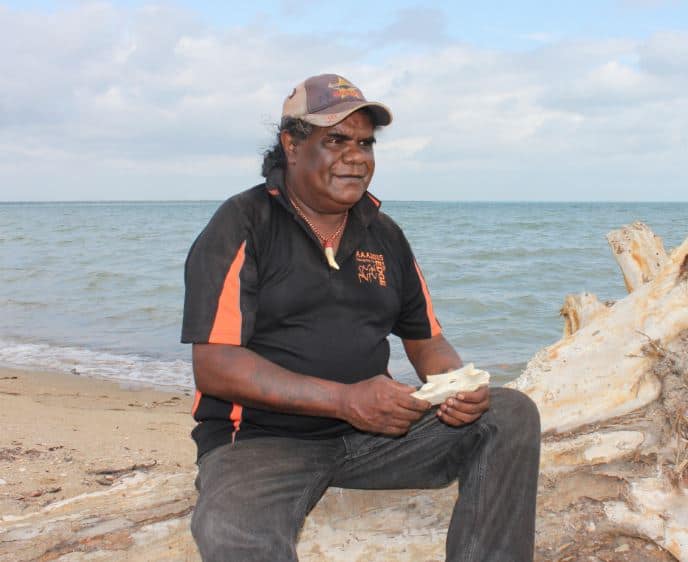 Elder Thomas Wales, of the Thanakwith Pine River People, believes it is important to look at Aboriginal history in new ways, because in many parts of Australia oral history may be lost. “I hope that what we do will open up doors for non-Aboriginal people to respect their country,” he says. It is good we can participate and instruct how we want things to be done. I’m learning more about our people, myself and my land. I’m encouraging others to open their doors and learn about their culture through science,” he said. (Image: Griffith University)
Elder Thomas Wales, of the Thanakwith Pine River People, believes it is important to look at Aboriginal history in new ways, because in many parts of Australia oral history may be lost. “I hope that what we do will open up doors for non-Aboriginal people to respect their country,” he says. It is good we can participate and instruct how we want things to be done. I’m learning more about our people, myself and my land. I’m encouraging others to open their doors and learn about their culture through science,” he said. (Image: Griffith University)
Regarding their linguistic ancestry, the University of Cambridge writes on its website:
“This, however, throws up a long-established paradox. Language experts are adamant that Pama-Nyungan languages are much younger, dating back 4,000 years, and coinciding with the appearance of new stone technologies in the archaeological record.”
“Scientists have long puzzled over how – if these communities were completely isolated from each other and the rest of the world – they ended up sharing a language family that is much younger? The traditional answer has been that there was a second migration into Australia 4,000 years ago, by people speaking this language.”
“But the new research finds no evidence of this. Instead, the team uncovered signs of a tiny gene flow, indicating a small population movement from north-east Australia across the continent, potentially at the time the Pama-Nyungan language and new stone tool technologies appeared.”
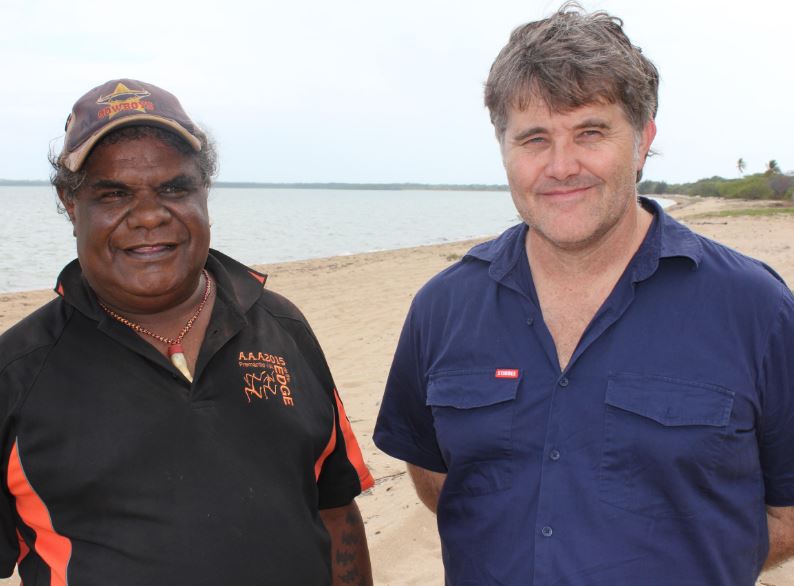 Elder Thomas Wales and researcher Dr. Michael Westaway, a Senior Research Fellow at Griffith University, in Mapoon. (Image: Griffith University)
Elder Thomas Wales and researcher Dr. Michael Westaway, a Senior Research Fellow at Griffith University, in Mapoon. (Image: Griffith University)
These courageous travellers, who must have endured forbidding environmental barriers, were small in number, but had a considerable, sweeping impact on the future of the continent’s culture. Mysteriously, however, the genetic evidence for them then vanishes. In other words, their culture and influential language survived – but they, as a distinctive group, disappeared.
Prof: Willerslev said:
“It’s a really weird scenario,” Willerslev said. “A few immigrants appear in different villages and communities around Australia. They change the way people speak and think; then they disappear, like ghosts.”
“And people just carry on living in isolation the same way they always have. This may have happened for religious or cultural reasons that we can only speculate about. But in genetic terms, we have never seen anything like it before.”
Citation: “A genomic history of Aboriginal Australia,” Manjinder S. Sandhu, Laurent Excoffier, David M. Lambert, Anna-Sapfo Malaspinas, Michael C. Westaway, Craig Muller, Vitor C. Sousa, Oscar Lao, Isabel Alves, Anders Bergström, Georgios Athanasiadis, Thomas Mailund, Mark Stoneking, Rasmus Nielsen, Jade Y. Cheng, Jacob E. Crawford, Tim H. Heupink, Enrico Macholdt, Robert A. Foley, Marta Mirazón Lahr, Claire Bowern, Jeffrey D. Wall, Stephan Peischl, Simon Rasmussen, Stephan Schiffels, Sankar Subramanian, Joanne L. Wright, Anders Albrechtsen, Chiara Barbieri, Isabelle Dupanloup, Anders Eriksson, Ashot Margaryan, Ida Moltke, Irina Pugach, Thorfinn S. Korneliussen, Ivan P. Levkivskyi, J. Víctor Moreno-Mayar, Chris Tyler-Smith, Richard Durbin, Joe Dortch, Andrea Manica, Mikkel H. Schierup, Shengyu Ni, Fernando Racimo, Martin Sikora, Yali Xue, Farhang A. Aghakhanian, Nicolas Brucato, Søren Brunak, Paula F. Campos, Warren Clark, Sturla Ellingvåg, Mark G. Thomas, Thomas Wales, Colleen Ma’run Wall, Stephen J. Oppenheimer, Gudjugudju Fourmile, Pascale Gerbault, Darren Injie, George Koki, Matthew Leavesley, Betty Logan, Aubrey Lynch, Elizabeth A. Matisoo-Smith, Peter J. McAllister, Alexander J. Mentzer, Mait Metspalu, Andrea B. Migliano, Les Murgha, Maude E. Phipps, William Pomat, Doc Reynolds, Francois-Xavier Ricaut, Peter Siba & Eske Willerslev. Nature. 21 September, 2016. DOI: 10.1038/nature1829.
Video – Genetic history of Aboriginal Australians
In this NaturalHistoryDK video, Prof. Professor Eske Willerslev explains how the changes in language and culture in the Australian continent occurred, and where the Aboriginal Australians originally came from.
